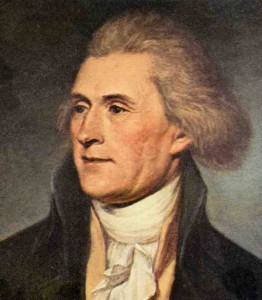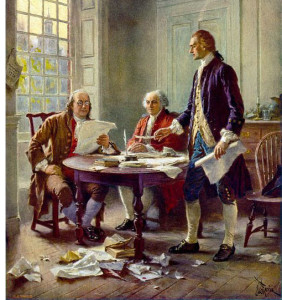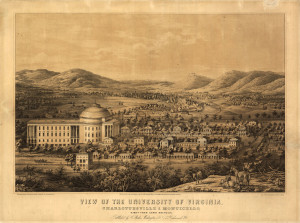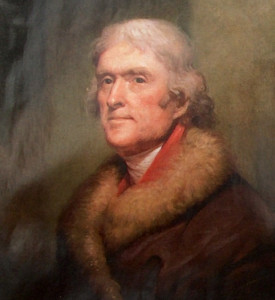Thomas Jefferson (born: April 13, 1743 died: July 4, 1826) was one of our most famous Presidents of the United States and the author of the Declaration of Independence. He was a member of the Continental Congress, Governor of Virginia, U.S. Minister to France and the first U.S. Secretary of the State under President George Washington and he also served as Vice President under President John Adams.
Jefferson was born in Shadwell, Virginia and his father was Peter Jefferson, a planter and surveyor and his mother was Jane Randolph, the daughter of a ship’s captain. When a friend of his father’s, William Randolph, died in 1745 his will stipulated that Peter Jefferson be appointed guardian of the Tuckahoe plantation located near Charlottesville, Virginia. The Jefferson family lived at Tuckahoe for seven years before eventually returning to Shadwell.
While the Jefferson family lived at Tuckahoe, Jefferson began his formal childhood education at the age of nine with a Presbyterian minister who taught him Latin, Greek and French then later he studied history, science and classic literature. At the age of 16, Jefferson enrolled at the College of William & Mary located in Williamsburg, Virginia where he continued his education and studied mathematics, metaphysics and philosophy. While he was at college, Jefferson met a law professor, George Wythe who was to become a major influence in his life and a mentor. Jefferson was an excellent student and graduated in only two years, afterwards he went to work as a law clerk for Wythe while he studied law was admitted to the Virginia bar in 1767.
Sadly, a few years before he went to college, his father died in 1757 and according to the terms of his will, Jefferson inherited approximately 5,000 acres of the former Tuckahoe tobacco plantation. So, at the age of 26, Jefferson began making plans for his home and since he had independently studied the principles of architecture, he based the design on a neoclassical style developed by Andrea Palladio who was a popular Italian Renaissance architect in eighteenth century Europe. The home was to be built on the top a mountain located on the property and Jefferson named it Monticello which was an Italian word meaning “little mount”. (Please see this month’s Travel Post for more information regarding the history of Thomas Jefferson’s Monticello home)
As the building continued at Monticello, Jefferson worked as a circuit court lawyer and in 1769 he began his political career when he represented the county of Albermarle in the Virginia House of Burgess. During this time he met and married Martha Wayles Skelton in 1772. The Jefferson’s marriage was a happy one and they shared many common interests. Both loved to read and enjoyed music, Jefferson played the violin and cello and Martha played the piano. Jefferson and Martha had six children during their short ten year marriage and only two of the children survived to adulthood. (Martha, known as Patsy, was born in 1772 and Mary, known as Polly, born in 1778.)
During their marriage, as the British colonies began to fight for their freedom from England in the American Revolutionary War, Jefferson served as a Virginia delegate to the Second Continental Congress and he soon established a life-long friendship with a fellow delegate from Massachusetts, John Adams. In 1776, when the Congress began to consider the resolution of independence, Jefferson was appointed to the committee and he was given the task of writing this important document. With minor changes the Congress voted to approve the final draft and the Declaration of Independence was signed by the delegates on July 4, 1776.
Near the end of 1776, Jefferson returned to Virginia to continue his political career and was elected to the Virginia House of Delegates. While serving on various committees, Jefferson helped draft the Virginia state constitution, the Bill for Religious Freedom in addition to 126 bills within three years. In 1779, Jefferson was elected the Governor of Virginia and a year later he moved the state capital from Williamsburg to Richmond. During the Revolutionary War Jefferson was ineffective as a governor in coordinating the Virginia militia and the British troops lead by General Benedict Arnold captured the city. Later, when General Cornwallis failed to capture him at Monticello, Jefferson retreated to his other plantation in Poplar Forest, his actions were deeply criticized at the time and consequently he was not re-elected to a third term as governor of Virginia.
Throughout the years as Jefferson was establishing his political career, first as a Virginia delegate for House of Burgess in Williamsburg, in Philadelphia for the Continental Congress and then in Richmond as the Virginia governor, he frequently returned home to see his wife and children. In 1782, Martha, who was now suffering from diabetes, died shortly after the birth of the couple’s sixth child, she was only 33 years old. While on her deathbed, Martha told Jefferson that she could not bear to have another woman raising her children and she pleaded with him to solemnly promise never to marry again, Jefferson was to honor that request and he never married again.
Following victory against the British in the Revolutionary War, the newly formed United States of America created a new government and Jefferson was once again appointed a Virginia delegate. After Martha’s death, a severely depressed Jefferson needed to distance himself from Monticello, so he eventually left the country to take a position as the Minister to France. Serving as minister (1785 – 1789), Jefferson enjoyed his time in Paris and was greatly influenced by the culture, arts, architecture and cuisine of France. In regards to his political position, Jefferson worked closely with Marguis de Lafayette to establish trade agreements between the United States and France to pay off the considerable debt incurred by the United States during the Revolutionary War. On a personal note, Jefferson arrived in Paris with his oldest daughter, Martha (Patsy) and several of his Monticello slaves, his other children remained in Virginia. By 1786, Jefferson had met and fallen in love a young married woman named Maria Cosway who was an artist and musician, after a short time she returned to England but they continued their lifelong friendship over the years through their correspondence. After Jefferson’s daughter Lucy had died in 1785, he sent for his youngest daughter Mary (Polly). She arrived in France accompanied by a young slave named Sally Hemings and it was during this time that Jefferson began his controversial relationship with her. After a five year stay in Paris, Jefferson returned to America shortly before the French Revolution started.
Upon returning to the United States in 1789, Jefferson took the position as the Secretary of State (1790 – 1793) in the cabinet of the newly elected President George Washington. Jefferson soon developed a contentious association with the Secretary of the Treasury, Alexander Hamilton, and they found themselves with increasingly opposite views regarding the consolidation of the federal government debts and the location of the capital. In addition, Jefferson worked diligently to secure first an admission from Great Britain that they had violated the Treaty of Paris, second that they vacate their military posts in the Northwest region of the United States and thirdly that the American slave owners be compensated for the loss of their slaves at the end of the Revolutionary War, he failed to achieve any of these goals and resigned his position at the end of 1793. Even though Jefferson had returned to Monticello temporarily ending his political life, he continued privately to oppose the policies of President Washington and specifically Hamilton.
In 1796, after President Washington decided not to return for a third term, Jefferson re-enter politics in a bid for the presidency but lost to his friend, John Adams. Jefferson became Vice President (1797 – 1801) and over the following years there were many political disagreements between the Federalist Adams and the Democratic-Republican Jefferson. But Adams was destined to serve only one term because in the 1800 election Jefferson challenged and defeated Adams by 73 to 65 electoral votes. Jefferson became the third President of the United States and he took the oath of office on March 4, 1801 in Washington D.C.
By the time of Jefferson’s Presidency, the United States had relatively few problems both domestic and foreign but many changes in the federal policies were to come during his administration. He first set out to immediately change Hamilton’s federal fiscal system which always went against Jefferson’s political beliefs. He began the process by eliminating several federal internal taxes, starting with the whiskey tax, and then he closed numerous unnecessary federal offices, drastically limited military expenses during peacetime and reorganized the national bank system.
During Jefferson’s first term as President (1801 – 1805), he negotiated the purchase of approximately 827,000 square miles of the Louisiana Territory from France in 1803 which almost doubled the size of the United States. In 1804, he appointed his personal secretary Meriwether Lewis who joined with William Clark to lead an exploration into the newly acquired territory. Known as the Lewis and Clark Expedition, the journey of the 45 men that would be called the Corps of Discovery, was important to Jefferson because it was meant to establish an American presence across the country and hopefully finding the infamous Northwest Passage through to the Pacific Ocean. Jefferson was very specific in his goals for the expedition and he personally tutored Lewis on such topics as cartography (map making) and astronomy to add navigation, natural history including botany and mineralogy to aid in documenting new discoveries and Jefferson also gave Lewis access to his extensive library of books located at his home in Monticello, VA for further preparation for the expedition. The Corps of Discovery assembled outside of St. Louis leaving in May 1804 to travel across the country with the assistance of various Native American guides, the most famous one being an Indian woman known as Sacajawea, to finally reach the Pacific Ocean along the Oregon Coast in November 1805 and successfully returning by September 1806. The Expedition not only established the United States claim to the territory but they were able to fully document and map the area and returned with numerous animal specimens and fossils as well as seeds and plants samples. (In the Entrance Hall at Jefferson’s Monticello home are displayed many of these items acquired during the Lewis and Clark Expedition)
Due to his successful first term and immense popularity, Jefferson easily won a second term during the 1804 election winning by an overwhelmingly 162 votes to 14 votes for the Federalist nominee, Charles Pinckney. Jefferson’s second term (1805 – 1809) had numerous problems and the United States political relations with Great Britain, which were never good, severely deteriorated while France, now under the leadership of Napoleon, became more aggressive in commerce trade negotiations with the United States. Another important issue during this time was the international slave trade; following the American Revolution all the states had informally abolished the lucrative international import and sale of slaves. Although Jefferson owned slaves on his Monticello plantation, he always treated them fairly but in general he felt that most owners treated their slaves cruelly and in response to South Carolina reopening its international slave trade Jefferson publicly denounced slavery as the violation of human rights. Then in 1807, Congress passed the Act Prohibiting the Importation of Slaves and it was signed into law by Jefferson in 1908, officially putting an end to the international slave trade but the United States domestic slave trade was still allowed and it continued to dominate commerce in the southern states.
When Jefferson’s presidency ended in 1809, he returned to his beloved Monticello. Fully retired from a political life, he still remained active in public life. Although he spent most of the remaining years pursuing his varied personal interests in the arts and science, Jefferson had always believed that education was the key to achieving greatness. By 1819, his plans to create an institution dedicated to higher learning were founded in the University of Virginia. His goal was to have the school free of church and religious influence and he also felt it was important to have it paid for by the general public thereby allowing poor students the same education as the wealthy ones. Jefferson planned the campus layout creating each individual academic department building organized around a central quadrangle. The buildings, which he personally designed, had multiple classrooms, faculty offices and student residences, even the landscape of the campus was also beautifully designed to include grass lawns and flower gardens. The University of Virginia was very important to Jefferson and he considered it his greatest achievement.
Although Jefferson enjoyed a relatively calm and peaceful life at Monticello with his family he also extensively and lavishly entertained visiting friends and political dignitaries with excellent food and drink. Toward the end of his life, Jefferson spent many hours going over his personal finances and tried to make arrangements to reconcile his massive debts. Sadly, Jefferson died in his bed at Monticello on July 4, 1826, he was 82 years old. The date also marked the fiftieth anniversary of the day that the Continental Congress approved the Declaration of Independence, a document that Jefferson is credited for writing, which officially marked the former British colonies freedom from England. On the same day, miles away at his home in Massachusetts, John Adams died five hours later. These two men, friendly adversaries and former Presidents, were the last surviving members of the Continental Congress to have signed the Declaration of Independence. Before his death, Jefferson had stipulated in his will the wish to be buried at the family cemetery at Monticello and a large stone obelisk marks the site with the inscription, “Here was buried Thomas Jefferson the author of the Declaration of American Independence, of the statute of Virginia for religious freedom and father of the University of Virginia”.




